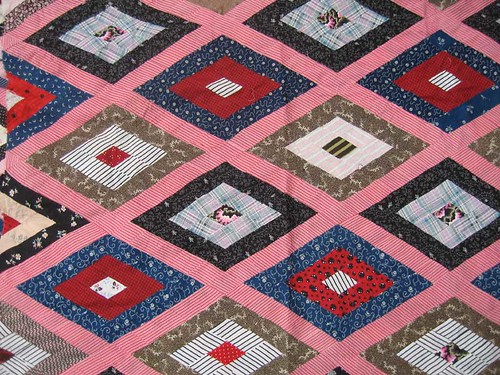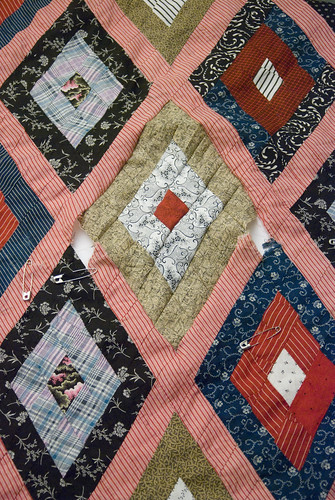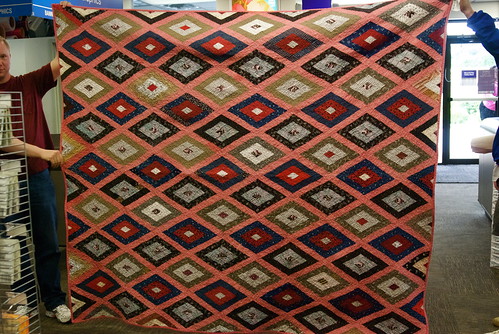The Island of Misfit Quilts (Quilt Blogger's Festival)
(Note that this entry is for the spring 2011 Quilt Bloggers' festival. Those of you who read domesticat.net regularly have seen this quilt and these photos before.)
The quilt top
Oregon Trail both is, and isn't, my work. I would love to tell you whose hands came first, but I cannot. Whoever she was, she is long gone.
This quilt top came to me through ebay, horrendously damaged through the hands of some previous owner over the past century, and needing significant repair. I bought it for its striking piecework, knowing it needed work, but I had no idea what I was getting into when I bought it. Here's what I saw in the auction:
 Chomped: the before shot
Chomped: the before shot
['Chomped: the before shot']
The seller and I agreed about the age of the quilt (our guesses: 1880s-1900s.) There's no way for you to feel the fabrics in this quilt top as part of this blog entry, but they were the oldest-feeling fabrics I've ever handled. They weren't fragile, not exactly, but they felt completely different from any other cottons I have ever worked with, and I was incredibly intimidated at first because I feared they were fragile.
I was so excited when I opened up the box and smelled the quilt top: old quilt tops feel different than modern quilts, and have a subtly different smell. I mentioned this to Amye when she and I talked about it; I don't know if it's the dyes or how the cotton was processed, but it feels different, looks different, smells different. It's delightful to me. It screams "I've been around a long, long time."
I loved Amye's suggestion of calling it "Oregon Trail." The quilt dates to the right time period, and since she lives in Oregon, that's effectively the journey this quilt would make. It was the first suggested name I heard that felt right. (--'Oregon Trail' quilt page)
I knew the bottom edge of this quilt had been hacked into, and I suspected there was other damage here and there. Even with the lower edge removed, it would still be around 78"x80", so if the bottom edge couldn't be repaired, I could just cut off the bottom and still have an excellent-sized quilt.
The repairs begin
If you've ever met me, you know that my intention was to save every bit of the quilt that I could. I loved the overly-intricate piecework; instead of using the double-pink fabric in long strips in the sashing, even the sashing was comprised of small diamonds of fabric:
 Diamonds, overall shot.
Diamonds, overall shot.
['Diamonds, overall shot']
My first order of business was to build replacements for all the damaged sections at the bottom, shown here:
 Testing scraps of reproduction fabrics
Testing scraps of reproduction fabrics
['Testing scraps of reproduction fabrics']
I rebuilt the broken areas, piece by piece, and then sewed in the replacement sections. The bottom looks like this now -- and yes, I know I need to trim those ragged corners off:
 All patches complete
All patches complete
['All patches complete']
In the last couple of nights, I did some further investigating of some weirdnesses I saw while playing with the quilt top. When I was turning it over, a flutter of fabric caught my eye, and when I looked closer I realized a section of the quilt (one of the diamond figures) was blown out, and flapping loosely. I was confused about why I'd never seen this on the front of the quilt, so I turned it over and went hunting — sure enough, one of the previous owners had [very clumsily] sewn a patch ON TOP of the blown-out figure. ('Scalpel of Choice')
I talked extensively about repairing this quilt top in "In for a penny, in for a pound.." so I'm going to quote it at length:
It's been a bit disheartening at times; I keep reminding myself that everything I fix means this will be a better and stronger quilt when it is finally finished, but I've reached that psychological point where I'm ready to just be done with mending the damned thing already, and getting the reward of moving on to quilting it.
I did finally get some photos of what had been done to it, though. It was hard to describe in text when I said that part of the quilt had blown out (in the wash, maybe?) and pieces roughly hacked out from the bottom and crudely sewn over the holes in a rough approximation of repair. It's easier shown than explained.
 Patched section, belowdecks
Patched section, belowdecks
['Patched section, belowdecks']
That's shot from the bottom of the quilt top, obviously. You can see the hole, and through it see what was sewn over it. Fixing this problem meant removing both layers, constructing a new piece that matched in color and pattern, and grafting it into place. Here's what the same area looked like, partway through the repair:
 Mostly sewn back in
Mostly sewn back in
['Mostly sewn back in']
I've been working my way up the quilt, looking for pieces with holes -- surprisingly few, given the age of the quilt top -- and further horrendous patches. I was hoping to find a patch that was so obviously bad a single photograph would suffice. I think this will do!
 In for a penny, in for a pound...
In for a penny, in for a pound...
['In for a penny, in for a pound']
If you look in the center of the photo, you'll see it -- and you'll cringe. I think even a complete novice at sewing knows this is NOT the way to do this repair. This isn't a tweed jacket. Don't slap a patch on it. Remove the broken bits entirely and replace them with new. Sure, it takes longer, but it rebuilds, not destroys.
[Sheesh.]
End quote. :)
I spent quite a few nights over a period of months going over this quilt, piece by piece, looking for damaged or weak pieces, clumsy patches, frayed bias edges on edges of the quilt top -- anything that might cause a problem when the quilt was finished. It was a labor of love, start to finish.
How did I finish it?
Amye, the recipient, picked out a gorgeous, delicate double-pink fabric from Margo's custom line of 1880s reproduction fabrics, Little Pink Stars. For quilting, I hunted through my two local shops that carry King Tut thread, and bought color #909, a variegated pink-on-pink thread whose two colors exactly matched the pinks the in star fabric. I chose to quilt it with a very dense loop pattern, with about 1/2" of spacing between each line, and burned through all the #909 thread I was able to find in Huntsville in short order. I couldn't get any more locally, and Jacob was about to visit from Minnesota, so he picked up several more spools from Bear Patch Quilting in White Bear Lake, MN so I could finish out the quilting with the color I wanted.
(Not a single damn thing about this quilt came easily.)
In this photo you can get an idea of the quilting density, the itty bitty nature of the little-pink-stars fabric, and how large chunks of the bottom row had to be replaced wholesale. This photo is a closeup of the section shown in the 'testing reproduction fabrics' photo, above.
 Splice job
Splice job
['Splice job']
Was it worth it?
Would I have bought the quilt top if I'd known the true extent of the damage? I think so; I still love the care in which it was assembled, and the striking color choices. Some woman put a great deal of care and love into hand-piecing this quilt top, and it deserved better than to sit in a drawer, unfinished and severely damaged, for another century.
There are intangible benefits from this repair process, as well. I got lucky; I learned of the amazing repro prints available at reproductionfabrics.com. Margo (the owner) is amazingly helpful both through email and through phone calls, and her having an 1880s repro double-pink striped fabric meant I was able to repair this quilt with a fabric that, while not perfect, blended well with the existing fabrics. I recommend her shop, her services, and her fabrics wholeheartedly. She had the delicately-patterned shirtings and antique reds I needed, as well.
I also had excellent help from Rachel at Patches and Stitches, my local fabric shop. I brought the quilt top over on my lunch hour, spread it out on the back table, and Rachel helped me hunt through the scrap bin, the 19th-century reproduction fabrics, and the rest of the store to find the rest of the fabrics I needed. They had a reproduction indigo fabric with delicate detailing that was spot-on perfect for replacing damaged blue fabric, and the most fortuitous woven plaid fabric I have ever stumbled upon. I believed finding a corresponding plaid fabric for repairing this quilt would be almost impossible; we found it in the scrap bin and it cost me all of fifty cents. (See the 'splice job' photo above, and marvel at that plaid fabric.)
I learned a lot about antique fabrics. I discovered that there's a lot of beauty to be had in 19th-century fabrics -- a time period I had previously not paid much attention to. I learned that even a heavily-damaged quilt top could be salvaged into a finished quilt that would be used and loved.
I also learned that Tenzing isn't gonna let this quilt go without a fight.
 The 'pre-loved' stage
The 'pre-loved' stage
 Snuggly Tenzing
Snuggly Tenzing
 Happy and snuggled
Happy and snuggled
 Mine. You cannot haz.
Mine. You cannot haz.
The end result
 Into the box you go!
Into the box you go!
['Into the box you go!']

Comments
This was an amazing quilt
This was an amazing quilt story. :) I loved reading about your dilemmas and the way you resolved the problems. How cool to repair and finish such an old quilt. Some woman looked down from Heaven and smiled because her work was finally legitimated. ;D
I have goosebumps. I am left
I have goosebumps. I am left speechless at this labour of love.
Bravo!
I'm so impressed with all the
I'm so impressed with all the time you invested in repairing this beauty!
So am I. It was — shall we
So am I. It was -- shall we say -- one of the crazier projects I've ever attempted. I do keep an eye on the quilt tops that come along through ebay, and very rarely bite on one. It has to be something exceptional, unusual -- something that makes me say, "I will regret it if I don't get my hands on this one." I just couldn't get this one out of my mind. I knew I wouldn't ever see another like it, and decided I wanted to repair it.
For some reason, our smaller cat (Tenzing, the 13-pounder) decided that this quilt was HIS quilt. I was so grateful when this one was bound, so I could finally wash it. I could not work on it, repair it, or even leave it out without Mr. Helpful settling in for a snooze. He's always helpful when I sew, but for this quilt he reached a new level of feline obsequiousness.
An amazing story and a
An amazing story and a beautiful quilt! I'm so glad you found it and gave it a new lease of life. Well done!!
What an intriguing story! I
What an intriguing story! I too, love the piecework and it looks so lovely once you've restored it. You have way more patience than most! Your thread choice is perfect. This quilt really has a story now!
This is so amazing! what a
This is so amazing! what a labor of love. So glad you worked so hard on this, it's beautiful! I just love diamonds, this is wonderful
Beautiful restoration! I'v
Beautiful restoration!
I've restored antique quilts but never one in quite the condition this one was in. Great job.
This story is one of both
This story is one of both love and respect for the art of quilting. You did a wonderful job and should be proud of your efforts.
Amazing story. You have
Amazing story. You have incredible patience, skill, and an eye for detail to be able to pull this off, and you did it! It is a beautiful finished quilt, but the process is a story all its own.
I'm so glad you chose to share this for the Bloggers Festival!
Very interesting story! I'm
Very interesting story! I'm so glad you ended up with this quilt and had the perseverance and talent to bring it to it's present glory. LOVE IT!!
WOW! What an amazing quilt!
WOW! What an amazing quilt! I'm so happy it is now finished and able to be loved!
That is an incredible quilt,
That is an incredible quilt, with an incredible story.
What a fantastic story and
What a fantastic story and what a beautiful result. Hate taking things apart so don't know that I could ever do the fabulous job you did. It's just lovely. Thanks for sharing and have a great day